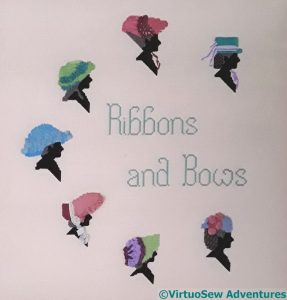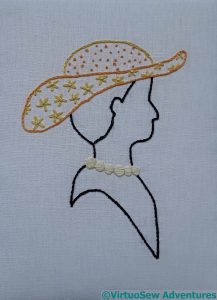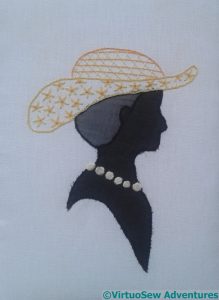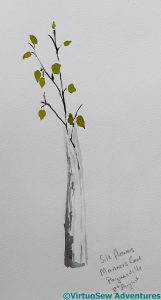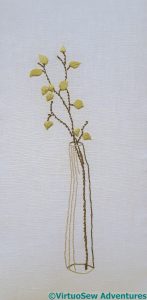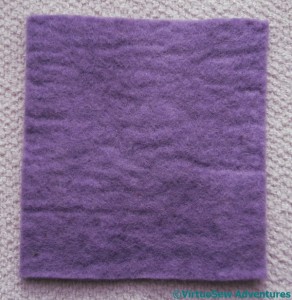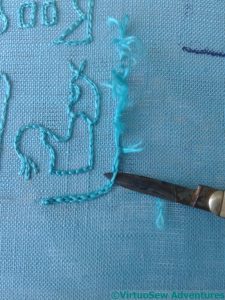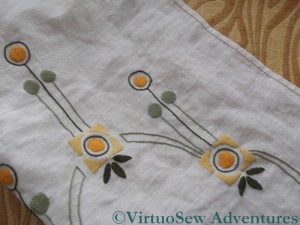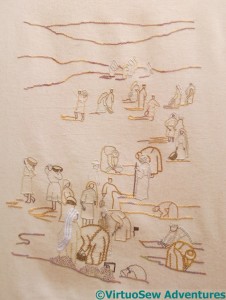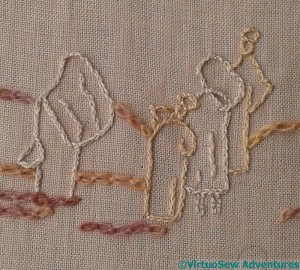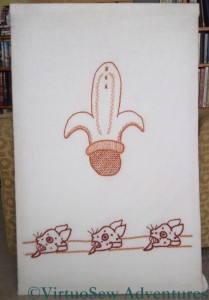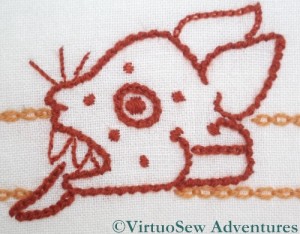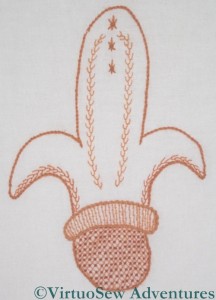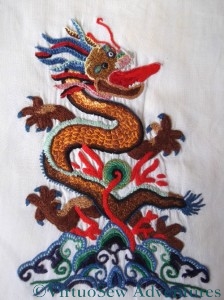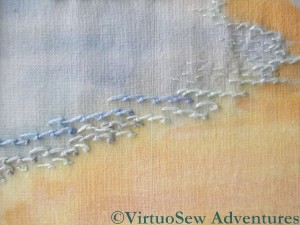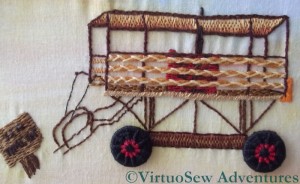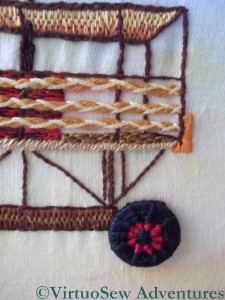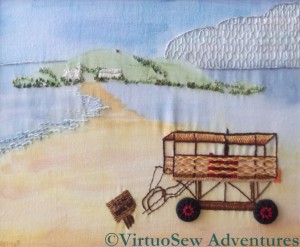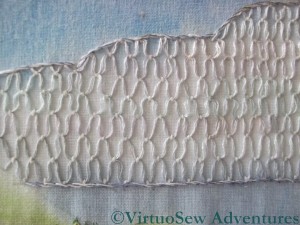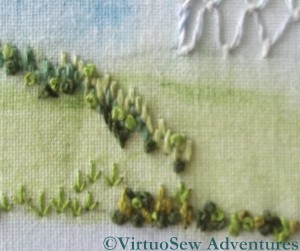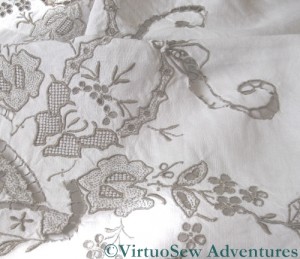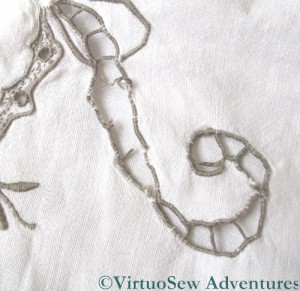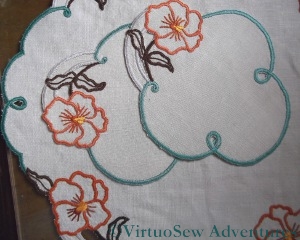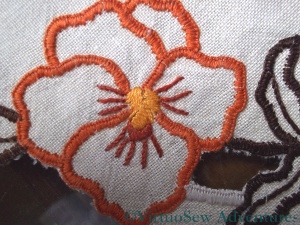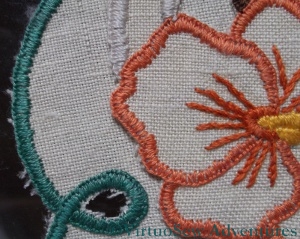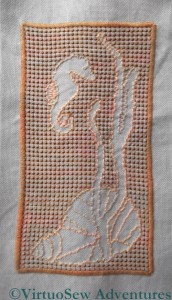Tag: General Embroidery
Same design, different stitches
I’ve been rummaging in a variety of boxes, because with “Leaving the Tyne, 1915” finished and on display, and two “Dreams of Amarna” pieces in a good state, I feel as though I have a bit of mental space and time to consider, not just the progress on the Dreams of Amarna, but also any other half-thought-through bits and pieces I may find.
I’m not sure whether that is going to be true, but I live in hope! These “bits and pieces” are particularly obscure and particularly hard to find something to do with.
These two Lovely Ladies were part of an exploration of stitch ideas and silhouettes, originally with the idea that they might become teaching pieces. They originate with a sampler of cross stitch and ribbonwork silhouettes I devised in “DevaStitch Designs” days.
When I thought of teaching, I extended the idea by enlarging the heads, and playing with stitchery to replace the ribbonwork. However, I’m not much of a teacher at the best of times, and when I asked a few people, I was told that the second version, with silk georgette layered to create the impression of the silhouette, would be daunting for beginners, and uninteresting for improvers.
Ouch.
So I’m still trying to work out what to do with them. I rather enjoyed doing the silk georgette (it’s held down with back stitch, then chain stitch, and then satin stitched over the top!), and it certainly makes the bead necklace stand out nicely. The two parts of the hat provide clear, distinct shapes to outline and fill with stitched patterns.
I still have some ideas for a lady in the cloche hat that I’m dying to put into action, but at the moment I have no good excuse to do so!
From Watercolour to Embroidery
This vase of flowers was on the table in a motel room we stayed in, many years ago. For some reason they caught my eye, and for our whole stay – which was full of activity and outings – I wanted to paint them. But we were never in the room for long enough during the daytime.
Finally, on the morning we were going to leave, I got out my paints, sat down, stared very hard, and painted this. I’ve noticed that if I really want to paint something, it often works much better than paintings I’ve done because I want to practise painting.
I don’t think I even bothered to take a photograph. Everything I wanted to remember about the vase is in the painting.
When we got home, however, it seemed to me that the painting offered possibilities as the basis for a simple embroidery.
A very simple embroidery, but, as you see, making use of a variety of stitches.
The vase was textured glass, not clear, and I represented that using lines of coral stitch among the stem stitch. I didn’t work it more densely, because I wanted it to have a certain lightness of touch.
The twigs were very rough and twiggy, so I used scroll stitch.
Finally, the simple shapes of the flowers were best represented using my neatest and most careful satin stitch. All I really wanted from them was the colour.
I haven’t the vaguest idea what to do with the embroidery, so I’ve laced it over a board to keep it tidy. But I thought you might be interested to see one of my very rarest stories – I know other designers often do detailed watercolours of their designs, but it’s not how I work. More often, I have a rough idea in my head, and work on each element while I’m planning the details of the next, waiting for the piece to tell me what it wants.
This has turned out well, but I’m still slightly bewildered that it happened at all!
Overcoming The Fear
This post has its roots in some conversations I’ve had with friends who are involved in education and enrichment, and in our mutual realisation that, although we may have different words for it and although we may face it differently, there is an experience we all recognize, and which it is very hard to coach students through.
No matter what you are doing, there is always a point early in a project where you find yourself staring at a blank sheet, wondering where to begin, what to do, and how to approach the challenge. This happens in every field of endeavour, whether it is obviously “creative” in the sense of painting, embroidery, or sculpture, or in a more academic field such as mathematics (The Australian is a mathematician, so I know about these things, even though I’m not one myself). And it isn’t limited to beginners.
You stare at your blank sheet, mind racing – or frozen – completely overwhelmed. Everyone devises their own strategies to overcome this, and the sooner you find your own, the easier your life will be.
The first is to pick something – anything – and try it. I am coming to realise that one of the signs of not being a beginner any more is the willingness to do work which may be abandoned – unpicked, reverse stitched, torn up as leading down a blind alley. Sometimes you have to see What is wrong, and How it is wrong before you can pick the Right Thing.
Another very useful strategy is to create limitations – to lay down rules that limit your choices. The idea is that part of the reason you’re overwhelmed is that with so much you could do, it’s almost impossible to choose which. In mathematical or computing terms, what you need to do is restrict the search space. It might seem paradoxical, but when you restrict your choices it can become very much easier to make progress. So the strategy of making a set of rules, or creating a framework within which to make decisions (to write a sonnet, say, instead of blank verse), can help you get started. Once you’ve got started, you can then decide to break the rules if the effect will be better. The important point is that you’re now over the Fear of Blanks and into the flow of the project.
When I’m working on a new project, I have to make decisions about the design, the fabric, the colours, the threads, and the stitches. Some of those decisions may be made for me. For example, if the project is “domestic” – a table runner, a cushion, the cover for Maggie the Magnifier – then I know where it’s going, and the colours will have to work in the room in question. Or if I’m embroidering a garment I already have, I have no choice about the fabric, and very little choice about the threads. I don’t have to worry about those, and can spend my energy on design and stitch choice.
But in the case of The View of the Excavation, for example, I had the design, but I then spent days – weeks! – staring at it and wondering what stitches and colours to use where.
So finally I devised a series of Rules:
1 – Narrow, plain stitches for distant figures, becoming broader and more textured close to the front;
2 – Pale colours for distant figures, more emphatic colours close to the front;
3 – Ground features in the same colour and stitch wherever they are.
I still had freedom to choose stitches, threads, and colours, but The Rules restricted the range within which I was choosing, and so made the decisions easier. Furthermore, because I’d picked a stitch and thread for ground features, I could get started, and think while I stitched, which meant that as I came to apply my various rules, the blank fabric was already no longer completely blank.
Each of the first two rules could be elaborated further, so for Rule One, I picked two different pale colours to choose between, and chose one stitch to use. Again, the decisions are thereby reduced and thus easier to make, which means that progress can be made while thinking about the next stage.
This is the manifestation in embroidery of one of the reasons that school maths can be dull and repetitive – it is trying to inculcate skills which will allow us to work mechanically on the simple stages or processes of a problem or puzzle, leaving the brain free to tackle to the more complex parts that will require serious, creative, and inventive thought. My sitting quietly working the “easy” bit while I think about my next step is exactly analogous to the mathematician rattling through some calculations while they consider what part of the problem to tackle next, or the writer writing a descriptive section while the back of their mind is busy mulling over the plot.
So next time you’re stuck over something, try this: pull some rules out of thin air and stick to them. Then break them. Thoroughly. And with enthusiasm!
The Aztec Blind
Our predecessors in our current house had a somewhat flamboyant decorative style, and we still haven’t replaced the Aztec inspired wallpaper in the hall. If the combination of terracotta and ochre makes it dark, that same colour combination also makes it seem warm, which in a draughty, 100-year-old house is a consummation devoutly to be wished. Especially since my Geordie friends tell me I’m “nesh” (translation: excessively susceptible to cold)!
Since it’s also Grade II listed, we can’t simply double glaze, so the first winter after we moved in, my mother suggested reviving the idea of “blackout blinds”, padded to reduce the draught. With my usual knack for complicating a perfectly simple project, I embellished the hall blind with an Aztec inspired embroidery in rusty coloured wools on a coarse cream linen.
I started with the Jaguar’s Head frieze across the bottom. The main outlines are in twisted chain stitch, and the spots and the eye are in rough satin stitch. The background lines in the lighter shade are in my favourite Cable Chain Stitch.
I enjoyed working the jaguars. The simplicity of the stitching and the rather stark line drawing combined to create something that was very easy to do.
Unfortunately I then lost my nerve. The jaguars alone could easily have created all the effect I wanted, but the expanse of bare fabric unnerved me slightly and I filled it with another motif.
There’s more going on in this one – feather stitch and star stitches, jacobean trellis couching and burden stitch (running vertically instead of horizontally).
I may yet unpick all that section and wash the fabric again to pull the threads back into line..
Although, as it stands, it provides a salutory reminder, every time I go past, that more isn’t necessarily more !
Kai Lung of the Golden Hours
This wonderfully contorted Imperial Dragon was another Needlewoman Magazine design (March 1934), and he got his name from the Golden Hours of Kai Lung, by Ernest Bramah, which I was reading at the time, because it had been mentioned in one of Dorothy L Sayer’s books (“Strong Poison”).
The pearl cotton I used was really too heavy for the base fabric – another old piece of linen – but it gave a fantastic lustre to his scales, which were worked using nested fly stitches (not my idea – I followed instructions on this piece!).
The tongue is closely-set stem stitch, the claws are fly stitch (so are the teeth – I think the designer liked fly stitch!) and the mane is made of interlocking blanket stitch. I worked very hard on this piece, to keep the stitches neat and even, and I used to take it with me to visit Grandmama when she was in hospital. There’d probably be a riot now if I sat at a hospital bedside, embroidery in hand, but Grandmama enjoyed watching me work and made a lot of useful and encouraging comments as well.
The magazine no longer had its transfer of the Dragon, which was intended as a Firescreen (other suggestions included the back of a bridge coat, a footstool, a cocktail tray, a cushion…), so I worked it at the size of the diagram in the magazine, on the back of a dress. Had I worked him full size, he’d have been too big for the dress.
I was thrilled when the wife of one of my father’s friends recognised it, told me that she had worked it herself when the magazine came out, and fished out the firescreen she had made using the design the next time we went to see them. She was the person who told me that you can tell he’s an Imperial Dragon, because he has five claws. She’d worked it in pastel shades to go with their drawing room of the time, and it was absolutely stunning. She and her husband are both dead now. I do hope that that screen found a happy home!
Happy Holidays – The Sea Tractor At Burgh Island (part two)
Continuing the Saga of the Sea Tractor…
I worked the sea edge in short lengths of scroll stitch in close pastel blues. The idea was to create the sense of the ripples at the edge as a wave settles and flows back down the beach – but only on one side of the sandy bar that leads out to the island. I wanted to create the sense of a prevailing wind that came at an angle so that the waves would be more noticeable on one side than the other.
Cloud, island, and sea suitably depicted, I could leap in and render the Sea Tractor in all its outlandish and spindly glory.
The Sea Tractor was great fun to do. I worked bi-coloured Dorset Buttons for the wheels, to evoke the painted metal hubs – pretty ambitious for my second and third Dorset Buttons ever!
The canopy and the base of the chassis seem to be in Brick Stitch, the main structural elements are either stem stitch or back stitch – the latter in particular for the terrifyingly spindly steps. Notice, by the way, that the steps themselves didn’t actually make it into the embroidered version. I wish I could say that was to emphasie the spindliness – that would be why I would do that now – but I have a strong suspicion that it was really either forgetfulness, or simply not being able to get the angles quite right.
I used heathered stranded cotton (red and black) for the engine-mounting, and ordinary black for the exhaust pipe that goes up through the roof.
The planks that create the side barriers were a bit of a challenge. In the end I settled on two long stitches in one colour, couched down in herringbone stitch in a lighter colour. I think they make pretty convincing planks, and looking at the detail, I even added the bumper at the back.
I didn’t include the barriers of the back or far side of the sea tractor, but I do recall thinking about that point. Even a painter – even a photo-realist painter – has to edit their image to make sure that it “reads” properly. Often this is a matter of making sure that the colours of things in the background recede sufficiently, but sometimes that isn’t enough. In this case I decided that adding those details would make the Sea Tractor even harder to work out, and discretion would be the better part of valour.
There really wasn’t enough stitching on this piece to qualify for a needlework competition, but I enjoyed working it!
Happy Holidays – The Sea Tractor at Burgh Island (part one)
This piece was intended as an entry in a competition run by “Needlecraft” Magazine about 25 years ago. The brief was to recreate “A Holiday Memory”, and as it happened, that year we had had a great adventure – a ride on the Sea Tractor at Burgh Island in Devon.
“Needlecraft” had also run an article shortly before, describing and teaching Dorset Buttons, and they seemed perfect for the Sea Tractor’s wheels. Since time was short and the complexity of the Sea Tractor likely to be time-consuming, I also experimented with a painted background on my cotton fabric.
In retrospect, the painted background isn’t hugely successful, and it doesn’t have enough stitchery to qualify for high marks in an embroidery competition, but I enjoyed adding those details I did create, and so often in these early pieces, you can see “Rachel-Now” and her ideas prefigured in the stitch choices of “Rachel-Then”.
Looking at it now, I might have done better to work the cloud filling smaller, in white rather than pastels, over a painted base, and without outlining it. Still when you consider that the whole thing was an experiment….!
The hillside details involved a lot of different stitches in lots of different greens. There are straight stitches, French Knots, chain stitches, and arrowhead stitches (upside down to look like shrubs). Again, if I were to work this now, there would be a great deal more stitchery in it, but I suspect that the combination of lack of time, and a disinclination to work areas of repetitive stitching led me to stop before I should have done.
What I can’t, now, recall, is whether I was pleased with it at the time. I’ve had it propped up in my living room since I rediscovered it, and I’m very tempted to crop it to show just the Sea Tractor itself – which would at least afford me the opportunity to re-block the piece and get rid of the ripples!
A little light repair work
One of the advantages of a family obsession with textiles is that no-one looks at me strangely when I get excited about a fabric, a thread, or a stitch.
One of the disadvantages is that between us we have a good many pieces stitched (probably) by an aunt, great-aunt or grandmother, which have been in constant use for years. Furthermore, as table-linen, if they get dirty, they just go in the washing machine. Usually this simply results in a cleaner cloth, but sometimes forty years of machine washing will catch up with us.
We don’t know who stitched this, or even whether it was bought by some ancestress of mine who wanted to rescue it from a jumble sale!
It seems to be a combination of cutwork and pulled work, with some elements I have yet to identify (fortunately I have a whole bookshelf of books to help!), and sadly, it needs mending.
As you see! There are buttonhole bars (or are they overcast bars?) which have actually broken, and in order to repair them I will need to reinstate some of the edgings as well.
Then there are other elements of the embroidery that I will need to identify and and replace. As far as I can tell, everything is worked with a single strand of stranded cotton, and would you believe, in spite of a considerable stash, I had to go out and buy some thread to match the existing one!
Another eBay Project
When I first discovered eBay, I bought a lot of transfers and some threads, and this dressing table set in cutwork arrived in one of the parcels, already stamped and half-heartedly started.
You’ve probably already gathered that I’m not very enthusiastic about working a one-stitch project, so I eyed it askance for a little while, but then it occurred to me that my grandmother’s dressing table would be the better for a little embellishment, and that this might make a good travelling project.
(Translation: Travelling Project – a small, simple project that can be easily taken on visits. Sometimes I use a large project as a travelling project, if it is simple enough – for example, the initial stages of the Map of Amarna, when I had only one thread colour to use and no decisions to make)
I had to buy a special pair of supersharp, super narrow scissors to deal with the cutwork. Truly scary – have I made the edge strong enough or haven’t I? The close-ups show that there were a few threads that weren’t quite properly trimmed, but they don’t show as much in real life.
And, as it turned out, I rather enjoyed keeping the buttonhole stitch close and neat, and didn’t find the project half as tedious as I feared!
Something I didn’t quite think through
I’m really not at all sure what to do with this. It’s an abandoned experiment that I recently rediscovered, and which is nagging me more than somewhat! I really should finish it, or do something with it. It was originally intended to be a traycloth, and I’ve also run out of the thread I was using to hem the piece. So, since I can’t remember what that was I have some unpicking to look forward to, whatever I decide to do with it.
I wanted to play with the idea of stitching the background, rather than the design. I also wanted to take advantage of the fact that Caron Collection colourways are dyed onto different threads (in this case, a fairly fine single-strand thread, and the heavy three-stranded type).
As it stands, I’m not happy with it. Maybe I chose to make the pulled work too large (it goes over four stitches in each direction), maybe it is too dark. Maybe I just haven’t done enough stitching yet?
I still think that doing most of the stitching in the background – a little like Assisi work – would be an interesting variation. Back to the drawing-board!

